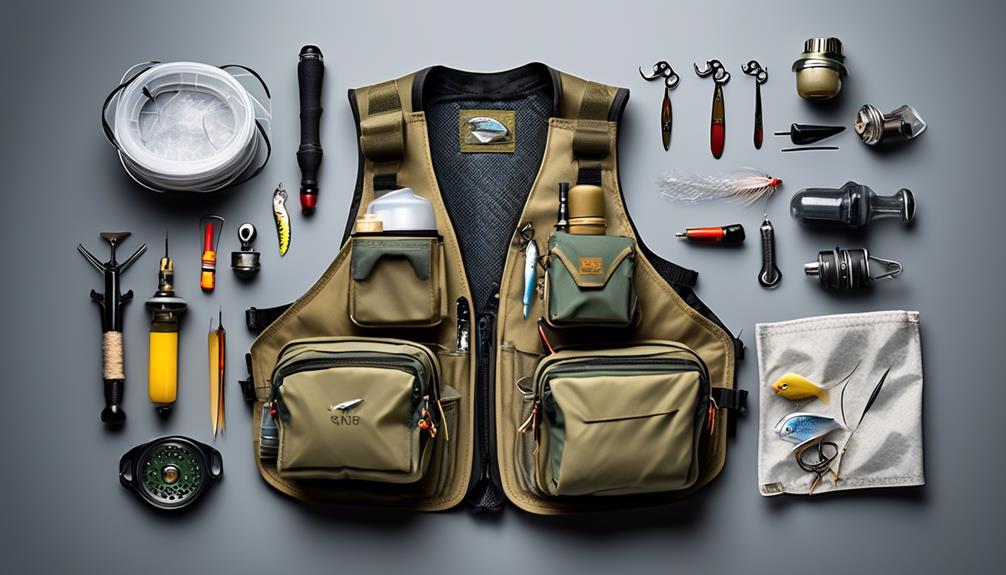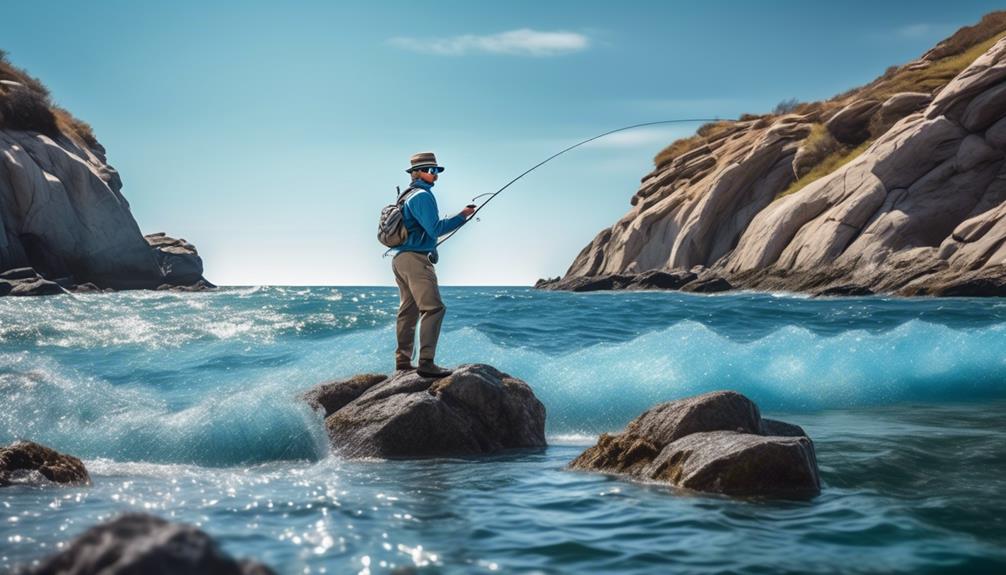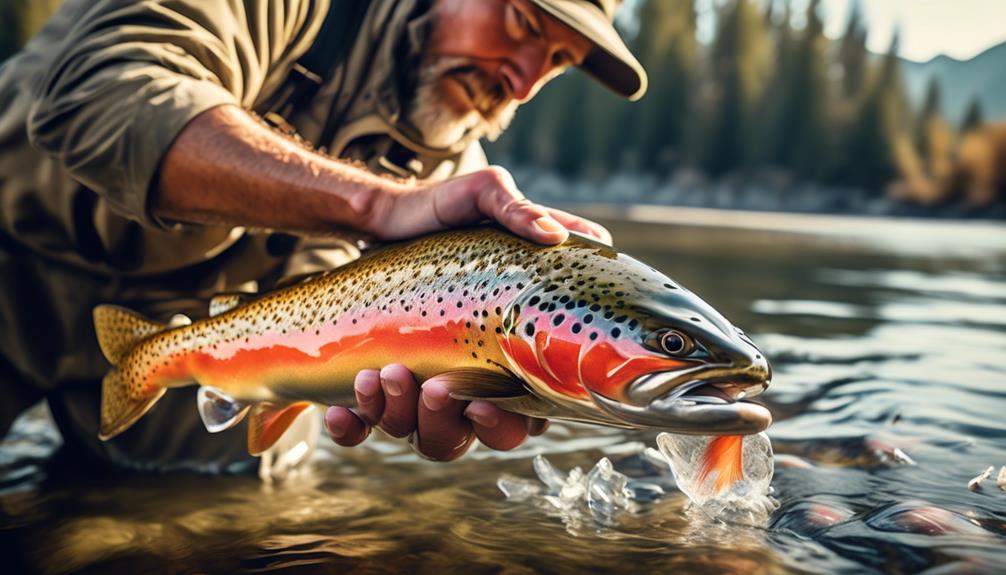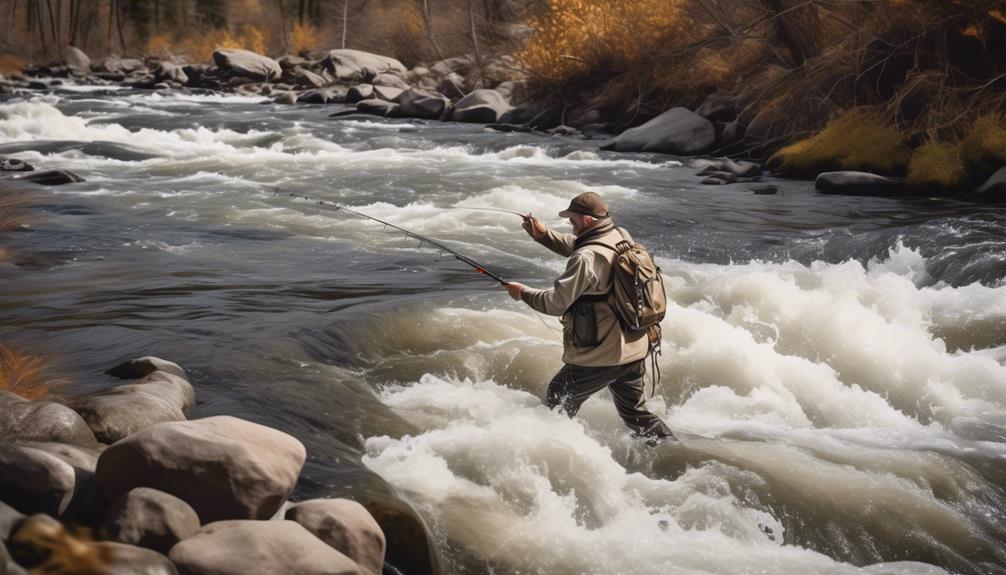Have you ever felt the exhilarating tug of a powerful saltwater fish on the end of your line, the sun glistening on the ocean's surface as you skillfully cast your fly into the waves?
As an angler, you know that successful saltwater fly fishing requires the right gear. From specialized rods and reels designed to handle the strength of ocean-dwelling species to essential accessories that can make or break your day on the water, the right equipment is crucial.
But what exactly do you need to ensure a successful saltwater fly fishing adventure? Let's dive into the must-have gear that will elevate your saltwater fly fishing game to new heights.
Rods and Reels
When selecting your saltwater fly fishing gear, it's crucial to choose rods and reels designed for the specific demands of this challenging environment. Rod action is a key consideration. Opt for a fast-action rod, which provides more power and allows for long, accurate casts essential for saltwater fishing. Additionally, the reel size is crucial. A larger reel with a good line capacity is necessary to handle the strong, fast fish typically found in saltwater.
In saltwater casting, the rod action plays a significant role. Fast-action rods are ideal for combating strong winds and casting heavier flies commonly used in saltwater fishing. They provide the necessary backbone to punch through the wind and deliver the fly to the target accurately.
When it comes to line retrieval, the reel size is essential. A larger reel with a high retrieval rate is advantageous as it allows for quicker line retrieval when fighting against powerful saltwater species.
Fly Lines and Leaders
To maximize your success in saltwater fly fishing, it's essential to carefully select the appropriate fly lines and leaders tailored for the specific challenges of this environment. Choosing the right fly line and leader is crucial for casting accurately and with control in the face of strong winds, challenging currents, and large, powerful fish.
Here are four essential considerations for fly lines and leaders in saltwater fly fishing:
- Weight Forward Fly Line: Opt for a weight forward fly line, which helps with long casts and enables better line control in windy conditions. The heavier front end allows for easier turnover and helps punch through the wind, essential for reaching distant targets.
- Saltwater-Specific Leaders: Invest in saltwater-specific leaders that have a heavier butt section and are designed to withstand the abrasion from saltwater species. These leaders are crucial for turning over large flies and handling the powerful runs of saltwater game fish.
- Knot Tying Skills: Enhance your knot tying skills to ensure strong connections between the fly line, leader, and fly. Practice tying secure knots such as the improved clinch knot, loop-to-loop connections, and the bimini twist to create reliable connections that won't fail when battling aggressive saltwater species.
- Leader Construction: Understand leader construction and the principles of tapering and strength. Customizing leaders to match the specific fishing conditions and target species will greatly improve your chances of success in saltwater fly fishing.
Flies and Fly-tying Materials
Selecting the right flies and fly-tying materials is essential for effectively targeting saltwater game fish and maximizing your success in this challenging environment. When it comes to saltwater fly fishing, fly patterns play a crucial role in enticing various saltwater species inhabiting different habitats. Understanding the diverse saltwater species and their habits will guide your choice of fly patterns and techniques.
For example, when targeting bonefish in shallow flats, using lightly weighted shrimp or crab patterns that imitate their natural prey can greatly increase your chances of a successful catch. On the other hand, when pursuing aggressive species like tarpon or barracuda in deeper waters, large baitfish patterns that can quickly sink and move with lifelike action are more effective.
Furthermore, having the right fly-tying materials is equally important. Saltwater flies need to be durable enough to withstand the harsh saltwater environment and the powerful fights put up by the targeted species. Materials such as synthetic fibers, durable threads, and corrosion-resistant hooks are essential for tying saltwater flies that can endure the rigors of saltwater fishing.
Understanding the principles of fly-tying and having a variety of high-quality materials at your disposal allows you to customize your flies to match specific baitfish or crustaceans, giving you a significant advantage when presenting the most lifelike imitations to saltwater game fish.
Wading Gear and Footwear
Ensuring that your saltwater fly fishing experience is successful and enjoyable, the right wading gear and footwear play a crucial role in providing stability and traction as you navigate the diverse coastal environments in pursuit of your target species. Here are some essential items to consider:
- Water Resistant Clothing: Invest in high-quality water-resistant clothing to stay dry and comfortable during your saltwater fly fishing excursions. Look for breathable materials that provide protection against the elements while allowing moisture to escape, keeping you dry from both the outside elements and perspiration.
- Proper Sunscreen Application: Protecting your skin from the sun's harmful rays is paramount when spending extended periods on the water. Choose a sunscreen with a high SPF rating and water-resistant properties to ensure it stays effective throughout the day. Remember to reapply as needed, especially after wading or if you've been sweating.
- Wading Boots: Opt for sturdy wading boots with ample ankle support and a solid grip to navigate various terrains, from rocky shorelines to sandy flats. Look for boots with durable soles that provide traction on both wet and dry surfaces, ensuring a secure foothold as you maneuver through the water.
- Gravel Guards: These essential accessories help keep debris out of your wading boots, preventing discomfort and potential damage. Look for guards that securely attach to your boots and effectively block sand, gravel, and other debris from entering, allowing you to focus on the thrill of the catch without distractions.
With the right wading gear and footwear, you'll be well-prepared to tackle the challenges of saltwater fly fishing while staying comfortable and protected.
Polarized Sunglasses
Invest in a pair of polarized sunglasses to enhance your visibility and reduce glare while saltwater fly fishing. When it comes to lens options, consider choosing sunglasses with polarized lenses that are specifically designed for fishing. These lenses are often available in different color options such as gray, copper, or amber, each offering unique benefits for various light conditions.
Additionally, look for sunglasses with durable frames and scratch-resistant lenses to ensure they can withstand the rigors of saltwater environments.
Several reputable brands offer polarized sunglasses tailored for saltwater fly fishing. Among them, Costa Del Mar, Maui Jim, and Smith Optics are highly recommended for their quality, durability, and effectiveness in reducing glare.
While the price range for polarized sunglasses can vary, investing in a good pair is crucial for protecting your eyes and improving your fishing experience. Prices for quality polarized sunglasses typically range from $150 to $300, but it's worth considering them as an essential piece of gear for your saltwater fly fishing outings.
Saltwater Fly Fishing Vests or Packs
Consider a high-quality saltwater fly fishing vest or pack to keep your essential gear organized and easily accessible while on the water. When choosing the right vest or pack, it's essential to prioritize storage options and organization, as well as comfort and breathability for long days on the water.
Here are four key features to look for in a saltwater fly fishing vest or pack:
- Ample Storage Pockets: Look for a vest or pack with multiple pockets of varying sizes. This will allow you to keep your flies, leaders, tippets, and other essential gear organized and easily accessible. Additionally, having specialized pockets for tools such as nippers, forceps, and hemostats can be incredibly convenient.
- Adjustable Straps and Fit: Opt for a vest or pack that offers adjustable straps and a customizable fit. This ensures that the vest or pack sits comfortably on your body, allowing for unrestricted movement while casting and wading. Look for options with breathable mesh panels to enhance comfort during hot days on the water.
- Integrated Hydration System: Some vests or packs come with integrated hydration systems, allowing you to stay hydrated without the need for a separate water bottle. This can be a game-changer during long fishing sessions, especially in the saltwater heat.
- Durability and Water Resistance: Given the saltwater environment, it's crucial to choose a vest or pack made from durable, water-resistant materials. This will help protect your gear from the corrosive effects of saltwater and ensure the longevity of your investment.
When selecting a saltwater fly fishing vest or pack, prioritize organization, comfort, and durability to enhance your overall fishing experience.
Tools and Accessories

When gearing up with tools and accessories for saltwater fly fishing, it's crucial to have the right equipment at your disposal for handling the demands of the saltwater environment. Two essential elements to consider are fly tying and line maintenance.
Fly tying tools such as a vise, scissors, and bobbin are indispensable for creating and repairing flies on the go. Saltwater flies are often larger and more durable than their freshwater counterparts, so having the right tools for fly tying is crucial for successful saltwater fly fishing.
Line maintenance is another critical aspect of saltwater fly fishing. The harsh saltwater environment can wreak havoc on fly lines, so having the right tools for line maintenance is essential. A line cleaner and dressing will help keep your line in top condition, ensuring smooth casts and efficient retrieves. Additionally, a line winder can be handy for quickly spooling and unspooling line as needed.
Other useful tools and accessories to consider include a quality pair of pliers for removing hooks, a reliable hook sharpener to ensure your hooks are always ready for action, and a stripping basket to help manage your line while wading. It's also important to have a waterproof fly box to protect your flies from the corrosive effects of saltwater.
Safety and First Aid Kit
Ensuring your safety and preparedness for any unexpected mishaps while saltwater fly fishing is essential. When venturing out into the open waters, it's crucial to be equipped with the necessary safety and first aid kit.
Here are a few items to consider including in your kit:
- Emergency Preparedness:
- Pack items such as a waterproof flashlight, a whistle, and a signaling mirror to attract attention and signal for help in case of emergencies.
- Additionally, consider carrying a waterproof map of the area and a GPS device to help navigate your way back to safety if needed.
- Medical Supplies:
- A well-stocked first aid kit is vital for treating any injuries that may occur during your fishing expedition.
- Include items such as adhesive bandages, gauze pads, antiseptic wipes, medical tape, tweezers, and pain relievers.
- It's also important to carry any personal medications you may require.
- Proper Hydration:
- Staying hydrated is crucial, especially when spending long hours in the sun.
- Carry an adequate supply of clean drinking water or a water purification system to ensure access to safe drinking water while out on the water.
- Sun Protection:
- Shield yourself from the sun's harmful rays by wearing a wide-brimmed hat, polarized sunglasses, and applying sunscreen with a high SPF rating.
- Protecting your skin from sunburn and potential long-term damage is essential for a safe and enjoyable fishing experience.
Frequently Asked Questions
Can You Recommend Any Specific Types of Sunscreen or Sun Protection for Saltwater Fly Fishing?
Make sure to protect yourself from the sun's rays while saltwater fly fishing. The best sun protection involves using sunscreen with high SPF, broad-spectrum, and water-resistant features. Recommended options include brands like Neutrogena, Coppertone, and Banana Boat.
What Are the Best Techniques for Handling and Releasing Fish in Saltwater Fly Fishing to Ensure Their Survival?
When handling and releasing fish in saltwater fly fishing, remember to use proper catch and release techniques to ensure their survival. Avoid netting and handle with wet hands. Quickly release the fish back into the water.
Are There Any Specific Regulations or Guidelines for Saltwater Fly Fishing in Certain Locations?
When fishing in specific locations, it's essential to follow regulations and guidelines. You should also consider tidal conditions and navigation. Remember to protect yourself with sunscreen, and also focus on handling, releasing, and cleaning your gear properly.
How Can I Properly Clean and Maintain My Saltwater Fly Fishing Gear to Prevent Corrosion and Damage?
To keep your saltwater fly fishing gear in top shape, use proper cleaning techniques to prevent corrosion. Regular maintenance like rinsing with freshwater and applying protective coatings will extend the life of your gear.
What Are Some Tips for Navigating and Fishing in Different Tidal Conditions in Saltwater Fly Fishing?
When fishing in different tidal conditions for saltwater fly fishing, remember to adapt your fly selection. Be mindful of boat fishing and wading techniques. Vary your approach to suit changing tides for successful angling.
Conclusion
So there you have it – the must-have gear for successful saltwater fly fishing.
With the right rods, reels, lines, and flies, along with essential accessories like polarized sunglasses and safety gear, you'll be ready to tackle the challenges of the open ocean.
Whether you're a seasoned angler or just starting out, having the right gear can make all the difference in your saltwater fly fishing adventures.
Happy fishing!



